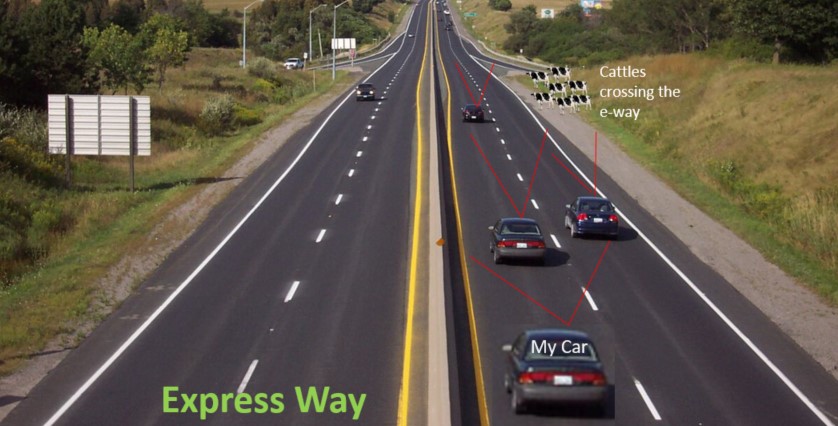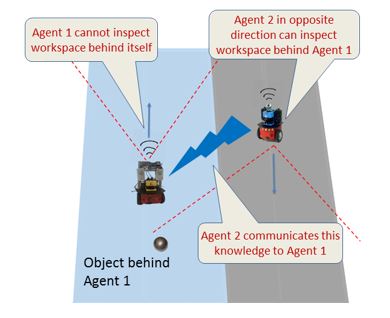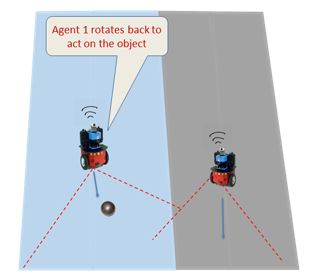POWER OF KNOWLEDGE AUGMENTATION WITH COLLABORATIVE INTELLIGENCE – APPLICATION TO CONNECTED VEHICLES
June 13, 2019
Co-authors: Pradyumna Saraph, Shreyans P. Bathiyan, Anil S. Patil, K V Chakravarthi, Dr. Sampath Yerra, Pal Shivkumar, Venugopalan Shankaran, and Umesh Vikram Singh
1. Real Incidence for Need of Collaboration
It was a very nice weather during the recent winter season when I was travelling on Ahmadabad – Mumbai highway by a rented car. Being one of the busiest routes, all the vehicles used to run in a lane with quite high speed keeping an optimum safe distance. An incident happened when we were running behind 3-4 vehicles approximately. Suddenly, I saw a small group of cattle coming fast towards the road to cross the highway to move to the other side of the road. Cattles coming towards the highway were at the periphery of the field of view for most of the car drivers, so as mine. Overall, this scenario is quite as depicted in <!–[if supportFields]> REF _Ref10469053 h * MERGEFORMAT <![endif]–>Figure 1
08D0C9EA79F9BACE118C8200AA004BA90B02000000080000000D0000005F00520065006600310030003400360039003000350033000000
<!–[if supportFields]><![endif]–> where all drivers are majorly focused on forward road.

Figure 1: Sketch of a situation at the time of the accident
As a passenger in a car free from driving tensions, I was enjoying the natural beauty around and noticed the approaching cattles quite early. I immediately intimated the car driver about the situation and he started applying the break accordingly. However, for all other vehicles ahead of our car, their driver noticed the situation quite lately only once cattles are very near the road. As an immediate reaction, drivers had no choice other than applying emergency breaks and change the directions to avoid the direct hits to cattles. As a consequence, the foremost vehicle hit the road divider and following two vehicles were about to hit each other and all were having varied damage level. Our vehicle driver could manage to control the speed and direction comfortably and avoid the accident situation with prior knowledge provided.
While I could avoid the accident by communicating the knowledge of situational awareness to driver of my car, other vehicles’ accident could have been avoided, or at least reduced severity, by sharing the same information with those vehicles ahead of me. With the latest technology developments, this concept of shared intelligence can be developed using ad-hoc network topology. These non-human agents (in this case – vehicles) can communicate with each other who collectively share their limited intelligence to achieve higher level intelligent functionality at system level which otherwise may not be possible at individual AI agent level.
Let us have a glimpse of our attempt to design such a collaborative intelligent system. Such collective and collaborative intelligence for enhanced efficiency of mission critical control units or agents in distributed environment based on decentralized architecture can be achieved through establishing instantaneous M2M network communication chain between agents (using individual limited knowledge). Knowledge augmentation from multiple agents is illustrated through an example – if some task appears for certain agent to which it is unaware due to limited situational awareness, other one who has the knowledge of that instantaneous situation alerts the designated agent to switch on that assigned task.
2. Illustration of Collaborative Intelligence
Such decentralized M2M (machine-to-machine) communication for enhanced situational awareness is illustrated based on multiple intelligent agents equipped with machine vision and potentially other sensors with light weight edge computing and localized M2M communication through ad-hoc network for real time operations. Real time M2M communication between agents is established using CG proprietary communication chain algorithm.
These intelligent agents are equipped with an optical camera for capturing the environment images instantaneously and a Raspberry-Pi for processing corresponding images on the agent itself – edge analytics. Agents communicates with each other all the time exchanging their health status. Image processing algorithms are designed using on-device analytics for generating actions for agents in real time. Agents travel in the designated zones while continuously scanning the self-zone looking for the object. Once detected, agent will act on the object with pre-defined functionality, e.g. pick up and drop. Typically agents have the broader field of view, beyond the self-zone.

Figure 2: Agent 2 gains extra knowledge from Agent 1’s zone
Individual agents can only view the workspace on the front side. As depicted in Figure 2, Agent 1 cannot see behind itself. However, another agent (Agent 2) busy in performing its own task in its designated zone, travelling in the opposite direction, locates the pending task to perform by Agent 1.

Figure 3: Agent 1 rotates back upon receiving alert from Agent 2
Agent 2, upon analyzing the situation, immediately shares this knowledge with Agent 1 about the pending task to complete in zone behind Agent 1. As depicted in Figure 3, Agent 1 receives the alert about the task and rotates back to locate and complete the task. Thus, with advanced knowledge through collaboration, Agent 1 complete the task which otherwise could not have been completed in time. Further, Agent 1 continue travelling and collaborative communications enhancing the overall system intelligence.
Theoretically, such an architecture can result in intensification of intelligence to any required level based on the degree of collaboration and number of collaborating agents.
3. So what we achieved
Many such situations can be illustrated showing higher potentials of collaborative mechanism with a truly democratized intelligence. This collaborative intelligence concept is illustrated with a proprietary IP platform – HAWDI platform, representing High Availability With Democratized Intelligence. Intelligent agents are thus empowered with local decision-making ability on device itself through enhanced situational awareness in relationship with each other in the communication chain.
Key benefits:
- Limited situational awareness transformed to universal knowledge (or at least amplified awareness) using M2M communication and decentralized AI
- High throughput and increased productivity
- Ad-hoc networking architecture, ideal for cloud-void internet-void environment
This is a general platform developed, called as HAWDI (High Availability With Democratized Intelligence). The platform illustrates higher order of intelligence through M2M communication, distributed intelligence, decentralized architecture, and virtual 1: N redundancy. This low-cost platform developed on Raspberry-Pi supports knowledge augmentation from multiple intelligent agents to perform designated range of tasks in spite of individual’s constraints (e.g. resources, capabilities, etc.).
The growing demand for collaborative intelligent devices across multiple applications and domains enable the industry transition from weak AI to ‘strong’ or ‘generic AI’. The use of decentralized architecture in Artificial Intelligence applications is going to become more prevalent considering the advantage of collective decision-making ability using collaborative intelligence. Current IIOT trends are projecting exponential demands of such highly efficient and cost-effective solutions without compromising human and machine safety in cloud denied and internet denied environment. The beauty of knowledge collaboration is limitless intelligence at the zero cost to the knowledge owner! This demonstration opens-up the possibilities of tapping $550bn [Gartner, April 2018] of forecasted global business value for smart, collaborative and intelligent products (edge devices) in the upcoming 5 years.
Author Profiles
 Pradyumna Saraph:
Pradyumna Saraph:
Technical architect, Digital Engineering and Manufacturing Services, Capgemini, India
Technical architect with 16 years of Software experience in Product engineering and distributed computing and building product from Scratch. Strong background in software architecture and design with excellent problem solving skills. Has expertise in software development in BFSI, virtualization, analytics and systems programming.
 Shreyans P. Bathiyan:
Shreyans P. Bathiyan:
Consultant, Digital Engineering and Manufacturing Services, Capgemini, India
Consultant with over 7.5 years into solution software development lifecycle centered around data science, data analytics, machine learning, machine vision, deep learning, edge analytics offerings across spot market, mining, healthcare, energy, and utilities market domains using open source tools such as R, Python, and Azure Cloud.
 Anil S. Patil:
Anil S. Patil:
Project Manager, Digital Engineering and Manufacturing Services, Capgemini, India
I am an Embedded Product Designer with experience in Specialization in Firmware Design and Development. My core experience is in Firmware Design and development consisting of various RTOSes and Linux. Proficient in Device Drivers development, C, C++ languages, Multi-threaded applications, TCP/IP Networking protocols etc
 Chakravarthi K. V.:
Chakravarthi K. V.:
Senior Manager, Digital Engineering and Manufacturing Services, Capgemini, India
Master’s in information technology with 14+ years’ experience in Embedded Systems. Expertise in designing 8, 16-bit microprocessor, and microcontroller based Single Board Computers, writing firmware’s and boot programs. Experience in 32bit ARM boards board bring up, Board Support Packages, Linux kernel porting, writing Linux device drivers and making IoT Edge devices.
 Dr. Sampath Yerra
Dr. Sampath Yerra
Program Manager, Digital Engineering and Manufacturing Services, Capgemini, India
With about 20 years of overall experience in Natural Resources Sector, Sampath has a strong background in scientific R & D, industrial consulting and applied innovation.
Possess diverse technical expertise including Advanced Analytics and Artificial Intelligence; Metrics Development and Visualization; Asset and Process Modelling, Simulation and Optimization; Materials Selection for Industrial Applications.
 Pal Shivkumar
Pal Shivkumar
Program Manager, Digital Engineering and Manufacturing Services, Capgemini, India
With about 20 years of overall experience in Solution Architect, Delivery, Innovation, Consulting, Project Management and Customer engagement. Expertise in Big Data infrastructure and ecosystem – Cloudera, Hortonworks, Apache Hadoop, and ecosystem component. Azure and AWS Big Data Analytics.
 Shankaran S. Venugopalan:
Shankaran S. Venugopalan:
Director, Digital Engineering and Manufacturing Services, Capgemini, India
Master of Science in Applied Physics, over 27 years of multi-sector global experience in manufacturing companies, product development and services companies. Heading teams for innovative solutions and industrialization of technologies spanning IoT, M2M, process and machine automations, sensing and controls. IEEE- Member of the Institute of Electrical and Electronics Engineers (IEEE).
 Umesh Vikram Singh:
Umesh Vikram Singh:
Vice President, Digital Engineering and Manufacturing Services, Capgemini, India
Over 32 years of multi-sector industrial experience delivering innovative solutioning and industrialization of cutting edge technologies spanning IoT, M2M, engineering analytics, process and machine automations, sensing and controls, Product and system engineering. Responsible for the growth and support of Engineering Analytics Practice. Managed Innovation Centre and Analytics Centre of Excellence.

 English | EN
English | EN 